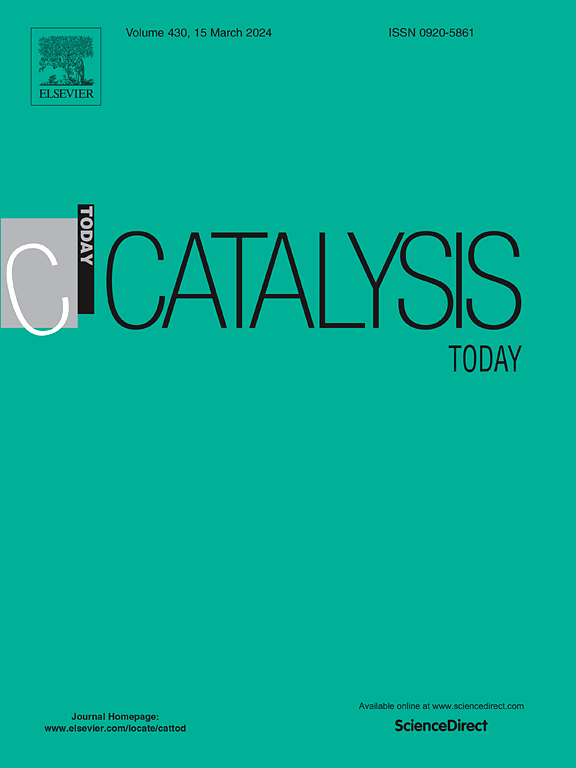异质结构光催化剂对实际废水中环境菌株的有效去除研究
IF 5.2
2区 化学
Q1 CHEMISTRY, APPLIED
引用次数: 0
摘要
获得清洁水对人类健康至关重要,但微生物污染带来了重大挑战。本研究考察了新型光催化催化剂:异质结构TiO2/AgBr和多面二氧化钛在紫外线和可见光下对微生物灭活的有效性。合成了两种催化剂并对其进行了表征。使用真实的废水样品和盐水溶液,针对革兰氏阳性和革兰氏阴性细菌,评估了性能。实验方法包括测试添加和不添加过硫酸氢盐的光催化剂,以评估其对失活效果的影响。结果表明,TiO2/AgBr催化剂具有较强的可见光吸收能力和电荷分离能力,优于面型二氧化钛催化剂,对环境菌株大肠杆菌完全失活,对实际废水中的粪肠球菌具有显著的失活作用。TiO2/AgBr包合过硫酸氢盐显著提高了失活率,显示出协同效应。在废水组成方面,该处理对COD的去除效果显著,其余研究参数保持稳定。两种催化剂都能有效地阻止细菌再生长达48 小时,强调其长期功效。总的来说,这些发现突出了TiO2/AgBr与过二硫酸氢盐结合作为一种有效的微生物灭活策略的潜在应用,促进了水处理技术在真实环境下的进步。本文章由计算机程序翻译,如有差异,请以英文原文为准。
Towards the effective removal of environmental strains of bacteria from real wastewater by heterostructured photocatalysts
Access to clean water is crucial for human health, yet microbial contamination poses significant challenges. This study investigates the effectiveness of novel photocatalytic catalysts: heterostructured TiO2/AgBr and faceted titanium dioxide, for microbial inactivation under ultraviolet and visible light. Both catalysts were synthesized and characterized. Performance was evaluated using real wastewater samples and saline solutions, targeting gram-positive and gram-negative bacteria. The experimental approach included testing the photocatalysts with and without the addition of peroxydisulfate to assess its impact on inactivation effectiveness. Results indicated that the TiO2/AgBr catalyst outperformed the faceted titanium dioxide one due to its superior visible light absorption and enhanced charge separation, achieving complete inactivation of environmental strains of Escherichia coli and significant inactivation for Enterococcus faecalis in real wastewater. The inclusion of peroxodisulfate with TiO2/AgBr significantly improved inactivation rates, demonstrating a synergistic effect. Regarding wastewater composition, the treatment achieves a significant COD removal while the rest of studied parameters remain stable. Both catalysts effectively prevented bacterial regrowth for up to 48 hours, underscoring its long-term efficacy. Overall, these findings highlight the potential application of TiO2/AgBr combined with peroxodisulfate as an effective strategy for microbial inactivation, contributing to the advancement in water treatment technologies across real environmental contexts.
求助全文
通过发布文献求助,成功后即可免费获取论文全文。
去求助
来源期刊

Catalysis Today
化学-工程:化工
CiteScore
11.50
自引率
3.80%
发文量
573
审稿时长
2.9 months
期刊介绍:
Catalysis Today focuses on the rapid publication of original invited papers devoted to currently important topics in catalysis and related subjects. The journal only publishes special issues (Proposing a Catalysis Today Special Issue), each of which is supervised by Guest Editors who recruit individual papers and oversee the peer review process. Catalysis Today offers researchers in the field of catalysis in-depth overviews of topical issues.
Both fundamental and applied aspects of catalysis are covered. Subjects such as catalysis of immobilized organometallic and biocatalytic systems are welcome. Subjects related to catalysis such as experimental techniques, adsorption, process technology, synthesis, in situ characterization, computational, theoretical modeling, imaging and others are included if there is a clear relationship to catalysis.
 求助内容:
求助内容: 应助结果提醒方式:
应助结果提醒方式:


